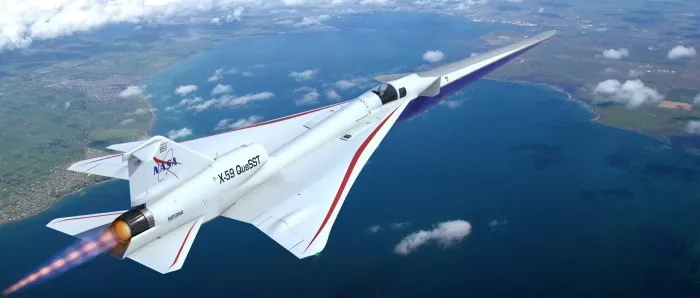In the previous article, we have learned that Lockheed Martin's supersonic aircraft x-59 is under development. Now let's further introduce the related R & D task quesst. Quesst is what NASA now calls its mission to achieve supersonic air travel on land. The new name, with an "s" Representing "supersonic", is inspired by NASA's supersonic flight research since its inception.

At the heart of the mission is a modern high-performance aircraft called the x-59, which is being built by Lockheed Martin's skunk factory in Palmdale, California.
Quesst replaces the original name of the mission: low altitude flight demonstration. (the US Air Force designated the demonstration aircraft as x-59 quesst as early as 2018).
"With quesst, we have found a name that more effectively conveys the purpose, relevance and excitement of the mission," said Peter Kuhn, NASA's mission integration manager in charge of quesst. Through quesst, NASA plans to prove that the x-59 can fly faster than sound without producing the huge sonic boom usually produced by supersonic aircraft. This thunderous sound is why the United States and other governments have banned most supersonic flights.
In cooperation with selected communities, NASA will fly the x-59 to understand the attenuated sonic boom effect on it. The agency will share survey data with regulators in the hope that they will consider formulating new rules and eventually lifting the ban.
With the launch of quesst, a new task ID comes with it -- a blue-green signature representing quesst elements.
The new mission graphics show stylized supersonic shock waves surrounding the research aircraft, above a family community. The image highlights the breakthrough research that will be conducted in several cities in the United States during the mission.
The design was inspired by images taken in NASA's 2019 airbos flight series, which recorded images of intersecting shock waves from supersonic jets.

The following is a breakdown of the design and its hue:
Supersonic shock wave, represented in green here, sound waves do not fuse. This is why the x-59 can produce a quieter sonic boom.
The shape of the plane represents the x-59. Although previously known as x-59 silent ultrasound technology, the aircraft will now be known as x-59.
The three houses represent a community that will provide data that will enable future commercial supersonic flights to take place on land.
The crescent represents land, highlighting a key and unique aspect of the mission - commercial supersonic flight on land.
In general, blue and green symbolize the earth and the value of NASA aviation research that humans experience every day.

Quesst program
To achieve its mission objectives, NASA has divided the quesst program into three phases. The first stage, which is also the current stage, focuses on the assembly of the x-59, followed by the initial flight planned later this year to prove the safety and performance of the aircraft.
The second phase, expected to take place during 2023, will focus on acoustic verification. At this stage, the mission will prove that the x-59 is ready to operate normally in the U.S. national airspace system. The plane will fly over NASA's Armstrong flight research center in Edwards, California, to prove that supersonic technology works as designed. These flights will also show that the tools used to predict and measure sonic boom levels are ready for use in phase III.
Perhaps the most anticipated aspect of the mission, the third phase will feature several communities where the x-59 flies over the United States, collecting data from the public to understand people's views on the voice of the x-59. This phase is expected to take place from 2024 to 2026. NASA has not yet selected these communities.
The mission will end in 2027 and the information collected in phase III will be shared with U.S. and international regulators. Through the information collected during the quesst mission, it is hoped that the regulatory authorities can consider the rules according to the sound volume of the aircraft, rather than based on arbitrary speed.
"The quesst mission has the potential to change what we currently know about air travel," Coen said. "The success of this mission will open the door to rapid air travel for all people around the world.".